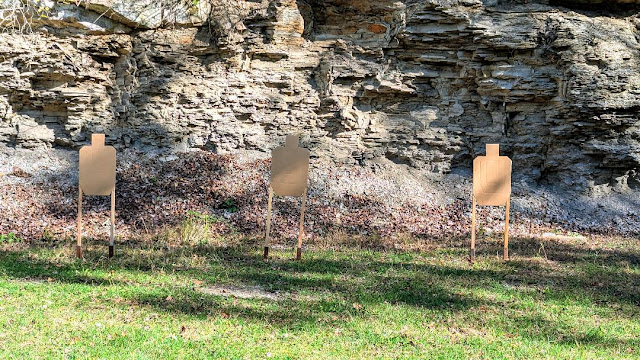This started with Ken Hackathorn. During one of his pistol classes, he demonstrated the time difference between two different engagements of two targets (VCAs).
The IDPA targets were side by side and Ken
had the following COFs.
COF A: Target Y gets a double tap, then Z
gets a double tap.
Compared that to:
COF B: Target Y gets a single, Z gets a
double tap, then Y gets a second single.
Which of the two scenarios gave Ken the best performance regarding time and power delivery? I have always thought practical or self-defense shooting was a thinking game.
 |
| I'm 10 yards from the center target. Can I deactivate each shooter before they shoot me? |
I have the actual numbers somewhere in my
notes, but I remember the time difference between the two courses of fire was
measured in hundreds of seconds. Ken
suggested that that tiny time difference makes no difference at all, and either
approach works.
To be clear from the start, Ken Hackathorn
is a world-class shooter, and I am an average shooter.
The question I want to answer is, how does
that compare to three targets with an AR chambered for .223 Rem?
I set up three targets about two yards
apart and stood ten yards in front of the center target. I selected the spacing of two yards because I
believe your attackers will not bunch up unless forced by the surroundings.
Here's my COF and best time.
COF C: Double tap targets A, then B then C. Here are my times.
1.67—1.87—2.68—2.90—3.62—3.81 seconds.
COF D: Single tap A, single tap B, double
tap C, single tap B, single tap A. My times
for this were:
1.92—2.75--3.58—4.32—5.14—6.09 seconds.
On the surface, double tapping each target
is faster. All six rounds fired in 3.81 seconds,
compared to the boarding house COF (everyone gets one before seconds are
served), which was 6.09 seconds. That’s
a difference of 2.28 seconds!
I think that analysis is faulty. Go back and look at the numbers. Let’s drop out the time it took to get a
second round in each target and look only at the first round on target. That gives us,
COF C (double
taps): 1.67—2.68—3.62 seconds.
COF
D (single tap): 1.92—2.75—3.58 seconds.
That's a wash.
At 10 yards, faced with three relatively
closely spaced VCAs armed with contact weapons, both COFs are equivalent.
Let’s dance around at the border of the
armchair Mall Commando territory.
One question arises: What’s the stopping power of a single .223 Rem
round 55gr FMJ? There isn’t any solid
scientific data to draw from. I believe,
extrapolated from handgun data and campfire stories, that a single .223 round
to the center of mass has medium to low turned-off-like-a-light-switch stopping
power.
But, as my goal, as a moral person, is to
stop any violent action, not cause death, one round center of mass to a VCA with
contact weapons might be sufficient.
I would have time for the injured VCA to approach me to perform needed
corrections.
But what if they have remote-controlled
weapons, like a bow and arrow or a handgun?
Now, the light switch factor becomes important. We could discuss what makes a person drop
their weapon and go unconscious. That's
for another day. I accept the argument
that if one round has a minor effect, two rounds will have a more significant effect.
The numbers suggest that the most useful
approach is to have everyone get one round, and anyone still being aggressive
gets a second or third helping.
One other factor from Mall Commando Land
is equivalent time. It's a simple idea,
and it bears much consideration. It says
that during the analysis phase, the time it takes for you to do something must
be given to your opponent to respond.
It's a version of taking turns.
Here are the times to the first round on
target.
COF C (double taps): 1.67—2.68—3.62
seconds.
With double taps following the rounds on
A, target B and C each get 1 second to act before you can engage B. Then target C gets 0.9 seconds more for a
total of 1.9 seconds to fire his gun at you.
A
B C
COF D (single tap): 1.92—2.75—3.58 seconds.
Now consider single taps. Following the round on A, targets B and C get
0.8 seconds to act before you can engage B.
Then target C gets 0.8 seconds more for a total of 1.6 seconds to fire
his gun at you.
Not much difference between them. Both times are long enough for someone as
committed as you to shoot you.
What conclusions can we draw from this
morass of numbers?
It suggests that standing out in the open
in a gunfight almost guarantees you'll be shot by the last person you
engage. USE COVER!
Practice to improve my performance. A faster initial shot followed by shaving a
half-second between each target could significantly reduce my opponent’s
response time.
There is the suspicion that increasing my
distance would degrade their pistol accuracy more than it would degrade my rifle
accuracy.
Run this experiment and time yourself. Then, look at the numbers and run this
analysis. I think you might be
surprised.
(Even as I sit here posting this, it occurs to me perhaps the optimal response, assuming you have to stand in the open and defend yourself, is single, single, then double tap. That put two rounds into the person C who has the most time to shoot you. This might be a step too far into Mall Commando Land.)
Comments
Post a Comment